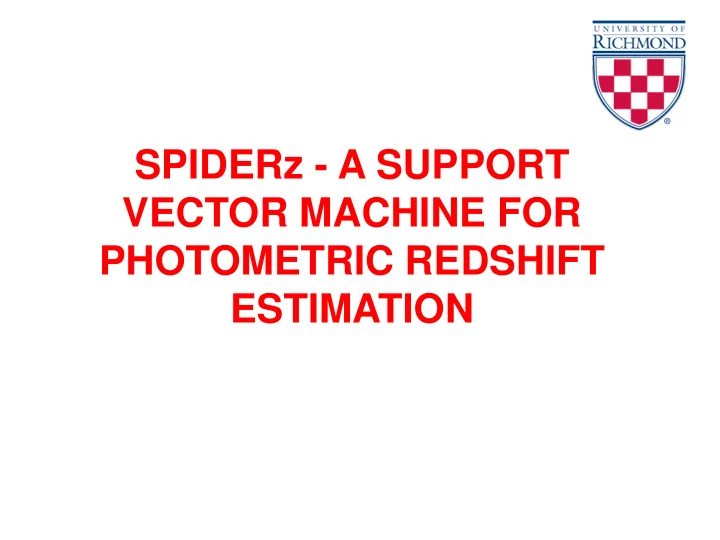

SPIDERz - A SUPPORT VECTOR MACHINE FOR PHOTOMETRIC REDSHIFT ESTIMATION
Orientation Galaxy redshifts are important • Many reasons! But Measuring galaxy spectra is too slow for large scale surveys The (potential) solution: Photo-z estimation • Estimate redshift from flux in a limited number of filter bands • Doing so accurately and with well understood errors is an important data challenge for current and future large multi-band extragalactic surveys
Why make a SVM for photo-z estimation? SVMs have been successfully applied in other areas of astrophysics Marton et al. 2016; Malek et al. 2013; • classification of objects into stellar, galactic, or active galaxy Hassan et al. 2013; Solarz et al 2013; categories Klement et al. 2011; Peng et al. 2002 • classification of structures in interstellar medium e.g Beaumont et al. 2011 • e.g Huertas-Company et al. 2007 galaxy morphological classification Past SVM attempts for photo-zs were intriguing but limited • low redshifts (z < 1) or simulated data Wadadekar 2004; Wang et al. 2007 SVMs are useful for exploring inclusion of parameters beyond photometry • learning algorithm can treat input parameters symmetrically In contrast with some other empirical methods • computational time for training is roughly linear in the number of input parameters • Our custom SVM method naturally outputs ‘effective’ redshift probability distribution (PDF)
Supervised learning with SVM TRAINING Training galaxies contain photometry and are 𝑦 𝑗 , 𝑨 𝑡𝑞𝑓𝑑 റ labeled with known spectroscopic redshifts: SVM ‘learns’ from galaxies in the training 𝑦 𝑗 = [u, b, g, r, i] set and builds a predictive model 𝑧 𝑗 = 𝑨 𝑡𝑞𝑓𝑑 M = 𝑔 റ 𝑦 𝑗 , 𝑨 𝑡𝑞𝑓𝑑 EVALUATION Evaluation galaxies contain only photometry: 𝑦 𝑘 = [u, b, g, r, i] The predictive model is applied to galaxies in the evaluation set to obtain photo-z estimations M( റ 𝑦 𝑘 ) = 𝑨 𝑞ℎ𝑝𝑢𝑝 We can compare photo-z estimations for the evaluation set to known spectroscopic redshifts to assess the performance of model.
SPIDERz : S u P port vector classification for IDE ntifying R edshifts Reported in • E. Jones & J. Singal, 2017, A&A , “Analysis of a Custom Support Vector Machine for Photometric Redshift Estimation and the Inclusion of Galaxy Shape Information.” in press (arXiv:1607.00044) Available from • spiderz.sourceforge.net
SPIDERz : SuPport vector classification for ID IDEntifying Redshifts Implements Support Vector Classification (SVC) in IDL • galaxy vectors are assigned class labels according to redshift • each bin represents a different class in the multi-class system • i.e. dataset ranging from z = 0 to 5 and with bins of size 0.1 forms a 51 class system Training • Multi-class solutions can be approximated with a series of binary class solutions • We use a one vs. one or ‘pairwise coupling’ approach that constructs and solves a binary class system for every possible pairing of classes: 𝑛(𝑛−1) 𝑛(𝑛−1) 𝑛 classes binary class problems with unique optimal hyperplane solutions 2 2 Evaluation 𝑛(𝑛−1) Predictive model consisting of binary classifiers is applied to evaluation set of galaxies 2 • The class (or redshift bin) to which a galaxy is most assigned becomes its final discrete predicted redshift value • The distribution of binary classification results resembles a probability distribution
COSMOSxHST Data Set • Same COSMOS photometry and morphology as previous but with available spectro-zs from HST (Momcheva et al., 2016) • Makes set with 3048 galaxies (6.8% z>2) 2.6% outliers RMS = .056 R-RMS = 0.04 10 band COSMOSxHST SPIDERz results, binsize 0.01, 1200 training
SPIDERz ‘effective PDF’ options 𝑛(𝑛−1) • Because of the binary class solutions we actually have a distribution 2 of photo-z results 𝑛(𝑛−1) • Could preserve all results as a photo-z PDF of sorts 2 • More later…
SPIDERz PDF options PDFs can reveal potential “catastrophic outliers” Double peaks - (Very photogenic example from COSMOSxHST 10 band) Spectro z = 0.19 Discrete photo z = 2.9
SPIDERz PDF options PDFs can reveal potential “catastrophic outliers” Double peaks - (Another example from COSMOSxHST 10 band) Spectro z = 2.49 Discrete photo z = 0.2
SPIDERz PDF options PDFs can reveal potential “catastrophic outliers” Weak peak - (Another example from COSMOSxHST 10 band) Discrete photo z = 0.4 Spectro z = 1.51
Identifying potential catastrophic outliers with EPDFs • Want to use characteristic features present in EPDFs to flag potential outlier or catastrophic outlier galaxy estimates • We focus on identifying distributions with multiple peaks
Flagging criteria for identifying multiply peaked EPDFs 1. redshift distance between candidate peak and primary peak: ∆𝑨 𝑞𝑓𝑏𝑙 = 𝑨 𝑗 − 𝑨 𝑞𝑠𝑗𝑛𝑏𝑠𝑧 2. relative probability compared to primary peak: 𝑞 𝑗 𝑞 𝑔 = 𝑞 𝑞𝑠𝑗𝑛𝑏𝑠𝑧
Flagged galaxies shown in red for test determinations performed with SPIDERz and using test data comprised of 5 optical bands (top) and 10 optical and infrared bands (bottom) 5-bands (u, V, r, i, z+) • Outliers reduced by ~28% • Catastrophic outliers reduced by ~77% • Incorrectly removed 5.0 % of non-outliers • RMS reduced by ~ 60% 10-bands (u, B, V, r, i, z+, Y, H, J, Ks) • Outliers reduced by ~37% • Catastrophic outliers reduced by ~60% • Incorrectly removed only 3.4% of non-outliers • RMS reduced by ~ 63%
Recommend
More recommend